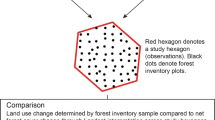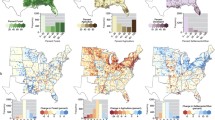Abstract
The relative contributions of double counting of carbon emissions between forest-to-nonforest cover change (FNCC) and forest wildfires are an unknown in estimating net forest carbon exchanges at large scales. This study employed land-cover change maps and forest fire data in the four representative states (Arkansas, California, Minnesota, and Washington) of the US for the period from 1992 to 2006 to evaluate forest carbon double counting effects based on land-cover change map, forest fire data, and USDA Forest Service Forest Inventory and Analysis data. The analyses were conducted at the county level and tallied to state level. Although the effects were small in the two eastern states because of small burned areas and low burn severity, substantial effects were found in the two western states. Carbon double counting was about 10 TgC (teragram 1012) in California and 6 TgC in Washington for the period 1992–2006 (at rates of 0.7 and 0.4 TgC per year), or 21.9 and 7.6% relative to total forest carbon emissions through FNCC in the two states, respectively. The effects were 0.2 and 0.1% in Arkansas and Minnesota, respectively. Variation in double counting effects within the states was also much higher in the western states compared with the eastern states. Our results suggested a general pattern that rates and amounts of double counting in forest carbon emissions between FNCC and fires were more evident and substantially different on a west–east dimension than that on a north–south dimension across the conterminous US during the study period.






Similar content being viewed by others
References
Anderson JR, Hardy EE, Roach JT, Witmer RE. 1976. A land use and land-cover classification system for use with remote sensing data. US Geological Survey Professional Paper 964, Reston, VA. pp 28.
Cairns MA, Hao W, Alvarado E, Haggerty PC. 2000. Carbon emissions from spring 1998 fires in tropical Mexico. In: Proceedings from “Crossing the millennium: integrating spatial technologies and ecological principles for a new age in fire management”. The Joint Fire Science Conference and Workshop. Moscow, ID: University of Idaho.
Campbell J, Donato D, Azuma D, Law B. 2007. Pyrogenic carbon emission from a large wildfire in Oregon, United States. J Geophys Res 112:G04014. doi:04010.01029/02007JG000451.
Chen X, Liu S, Zhu Z, Vogelmann J, Li Z, Ohlen D. 2011. Estimating aboveground forest biomass carbon and fire consumption in the U.S. Utah High Plateaus using data from the Forest Inventory and Analysis Program, Landsat, and LANDFIRE. Ecol Ind 11:140–8.
DeFries RS, Townshend JRG. 1994. Global land-cover: comparison of ground-based data set to classification with AVHRR data. In: Foody GM, Curran P, Eds. Environmental remote sensing from regional to global scales. Chichester: Wiley. p 84–110.
DeFries RS, Houghton RA, Hansen MC, Field CB, Skole D, Townshend J. 2002. Carbon emissions from tropical deforestation and regrowth based on satellite observations for the 1980s and 1990s. PNAS 99:14256–61.
Eidenshink J, Schwind B, Brewer K, Zhu Z, Quayle B, Howard S. 2007. A project for monitoring trends in burn severity. Fire Ecol 3:3–21.
French NHF, Kasischke ES, Stocks BJ, Mudd JP, Lee BS, Martell DL. 2000. Carbon released during fires in North American boreal forests. In: Kasischke ES, Stocks BJ, Eds. Fire, climate change and carbon cycling in the boreal forest. Ecological studies series. New York: Springer. pp 377–88.
French NHF, Kasischke ES, Hall RJ, Murphy KA, Verbyla DL, Hoy EE, Allen JL. 2008. Using Landsat data to assess fire and burn severity in the North American boreal forest region: an overview and summary of results. Int J Wildland Fire 17:443–62.
French NHF, Groot WJd, Jenkins LK, Rogers BM, Alvarado E, Amiro B, Jong Bd, Goetz S, Hoy E, Hyer E, Keane R, Law BE, McKenzie D, McNulty SG, Ottmar R, Perez-Salicrup DR, Randerson J, Robertson KM, Turetsky M. 2011. Model comparisons for estimating carbon emissions from North American wildland fire. J Geophys Res 116. doi:10.1029/2010JG001469.
Friedl MA, McIver DK, Hodges JCF, Zhang X, Muchoney D, Strahler AH, Woodcock CE, Gopal S, Schnieder A, Cooper A, Baccini A, Gao F, Schaaf C. 2002. Global land cover from MODIS: algorithms and early results. Remote Sens Environ 83:135–48.
Fry JA, Coan MJ, Homer CG, Meyer DK, Wickham JD. 2009. Completion of the National Land Cover Database (NLCD) 1992–2001 land-cover Change Retrofit product report no. Open-File Report 2008–1379, U.S., Department of the Interior, U.S. Geological Survey, Reston, VA. pp 18.
Fry J, Xian G, Jin S, Dewitz J, Homer C, Yang L, Barnes C, Herold N, Wickham J. 2011. Completion of the 2006 National Land Cover Database for the Conterminous United States. Photogramm Eng Remote Sens 77:858–64.
Gustafson EJ, Shvidenko AZ, Scheller RM. 2011. Effectiveness of forest management strategies to mitigate effects of global change in south-central Siberia. Can J For Res 41:1405–21.
Gutman G, Byrnes R, Masek J, Covington S, Justice C, Franks S, Headley R. 2008. Towards monitoring land-cover and land-use changes at a global scale: the Global Land Survey 2005. Photogramm Eng Remote Sens 74:6–10.
Heath LS, Smith JE, Skog KE, Nowak D, Woodall C. 2011. Managed forest carbon estimates for the U.S. Greenhouse Gas Inventory, 1990–2008. J Forest 109:167–73.
Hollister JW, Paul JF, August PV, Copeland JL, Gonzalez ML. 2004. Assessing the accuracy of National Land Cover Dataset area estimates at multiple spatial extents. Photogramm Eng Remote Sens 70:405–14.
Homer C, Huang C, Yang L, Wylie B, Coan M. 2004. Development of a 2001 National Landcover Database for the United States. Photogramm Eng Remote Sens 70:829–40.
Homer CH, Fry JA, Barnes CA. 2012. The National Land Cover Database, U.S. Geological Survey Fact Sheet 2012-3020. pp 4.
Houghton RA. 1995. Land-use change and the carbon cycle. Glob Change Biol 1:275–87.
Houghton RA. 1999. The annual net flux of carbon to the atmosphere from changes in land use 1850–1990. Tellus 51B:298–313.
Houghton RA. 2010. How well do we know the flux of CO2 from land-use change? Tellus 62B:337–51.
Kasischke ES, French NHF, Bourgeau-Chavez LL, Christensen NL Jr. 1995. Estimating release of carbon from 1990 and 1991 forest fires in Alaska. J Geophys Res 100:2941–51.
Keane RE, Ryan KC, Running SW. 1996. Simulating effects of fire on northern Rocky Mountain landscapes with the ecological process model FIRE-BGC. Tree Physiol 16:319–31.
Meigs GW, Donato DC, Campbell JL, Martin JG, Law BE. 2009. Forest fire impacts on carbon uptake, storage, and emission: the role of burn severity in the Eastern Cascades, Oregon. Ecosystems 12:1246–67.
MRLC. 2011. Multi-Resolution Land Characteristics consortium. http://www.mrlc.gov/. Accessed 26 July 2011.
MTBS. 2010. Monitoring Trends in Burn Severity (MTBS). http://www.mtbs.gov/. Accessed 17 Aug 2011.
Oliver CD, Larson BC. 1996. Forest stand dynamics. New York: Wiley. pp 520.
Randerson JT, Chapin FSIII, Harden JW, Neff JC, Harmon ME. 2002. Net ecosystem production: a comprehensive measure of net carbon accumulation by ecosystems. Ecol Appl 12:937–47.
Seiler W, Crutzen PJ. 1980. Estimates of gross and net fluxes of carbon between the biosphere and the atmosphere from biomass burning. Clim Chang 2:207–47.
Smith JE, Heath LS. 2008. Carbon stocks and stock changes in U.S. forests. In: U.S. Agriculture and Forestry Greenhouse Gas Inventory: 1990–2005. U.S. Department of Agriculture, Office of the Chief Economist, Technical Bulletin No. 1921, Washington, DC. pp 65–80 C61–C67.
Smith JE, Heath LS, Skog KE, Birdsey RA. 2006. Methods for calculating forest ecosystem and harvested carbon with standard estimates for forest types of the United States. USDA Forest Service, Northeastern Research Station, NE-343, Newtown Square, PA.
Townshend JR, Latham J, Arino O, Balstad R, Belward A, Conant R, Elvidge C, Feuquay J, El Hadani D, Herold M, Janetos A, Justice CO, Jiyuan L, Loveland T, Nachtergaele F, Ojima D, Maiden M, Palazzo F, Schmullius C, Sessa R, Singh A, Tschirley J, Yamamoto H. 2008. Integrated global observations of the land: an IGOS-P theme, IGOL Report No. 8, GTOS 54, United Nations FAO, Rome.
Turner DP, Göckede M, Law BE, Ritts WD, Cohen WB, Yang Z, Hubiburg T, Kennedy R, Duane M. 2011a. Multiple constraint analysis of regional land-surface carbon flux. Tellus 63B:207–21.
Turner DP, Ritts WD, Yang Z, Kennedy RE, Cohen WB, Duane MV, Thornton PE, Law BE. 2011b. Decadal trends in net ecosystem production and net ecosystem carbon balance for a regional socioecological system. For Ecol Manage 262:1318–25.
van der Werf GR, Randerson JT, Giglio L, Collatz GJ, Mu M, Kasibhatla PS, Morton DC, DeFries RS, Jin Y, van Leeuwen TT. 2010. Global fire emissions and the contribution of deforestation, savanna, forest, agricultural, and peat fires (1997–2009). Atmos Chem Phys 10:11707–35.
Vogelmann JE, Howard SM, Yang L, Larson CR, Wylie BK, Van Driel N. 2001. Completion of the 1990s National Land Cover Dataset for the conterminous United States from Landsat Thematic Mapper data and ancillary data sources. Photogramm Eng Remote Sens 67:650–2.
Volney W, Fleming R. 2000. Climate change and impacts of boreal forest insects. Agric Ecosyst Environ 82:283–94.
Xian G, Homer C, Fry J. 2009. Updating the 2001 National Land Cover Database land-cover classification to 2006 by using Landsat imagery change detection methods. Remote Sens Environ 113:1133–47.
Zheng D, Heath LS, Ducey MJ, Smith JE. 2011. Carbon changes in conterminous US forests associated with growth and major disturbances: 1992–2001. Environ Res Lett 6:014012.
Acknowledgments
Funding support for this study was primarily from the USDA Forest Service, through grant 05-DG-11242343-074 and partly from the Research Joint Venture Agreement between the UNH and USFS Northern Research Station Work Unit NRS-5 (09JV11242305052). The authors thank Christopher Woodall for his valuable comments on the earlier version of this manuscript.
Author information
Authors and Affiliations
Corresponding author
Additional information
Author Contributions
D. Z. contributed to the overall study design, data analyses, and wrote the manuscript. L. H. contributed to overall study design, constructive discussions and writing. M. D. contributed to the study methods and writing. B. Q. conducted fire data development, analyses, and writing.
Rights and permissions
About this article
Cite this article
Zheng, D., Heath, L.S., Ducey, M.J. et al. Assessing Double Counting of Carbon Emissions Between Forest Land-Cover Change and Forest Wildfires: A Case Study in the United States, 1992–2006. Ecosystems 16, 310–322 (2013). https://doi.org/10.1007/s10021-012-9616-1
Received:
Accepted:
Published:
Issue Date:
DOI: https://doi.org/10.1007/s10021-012-9616-1




